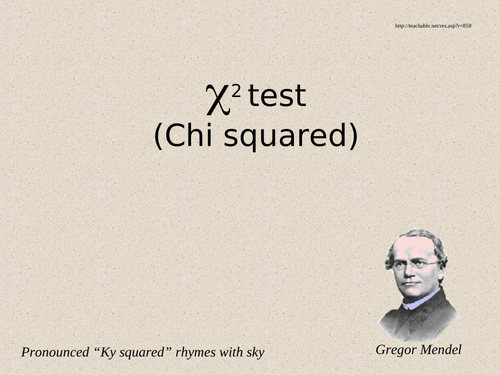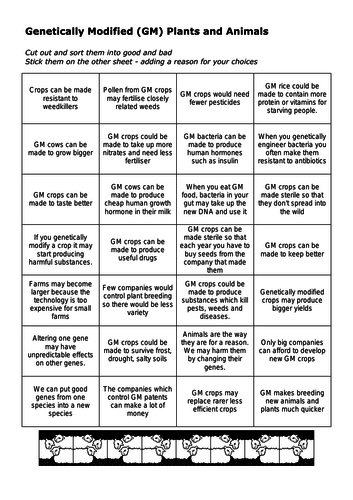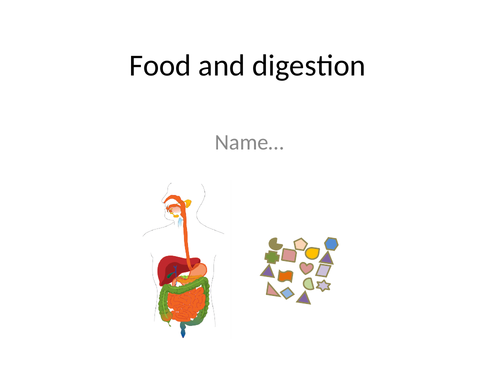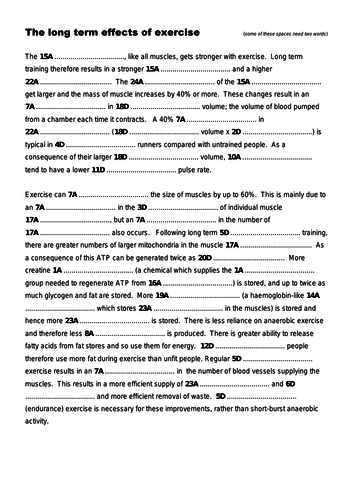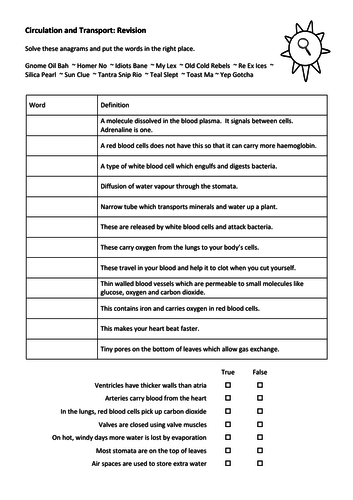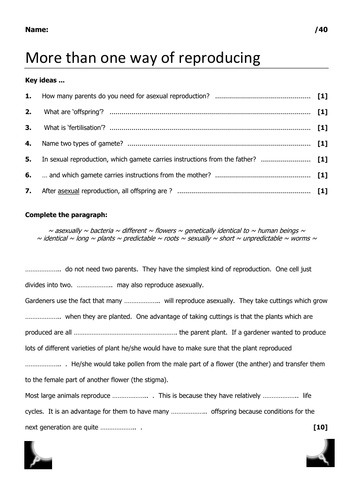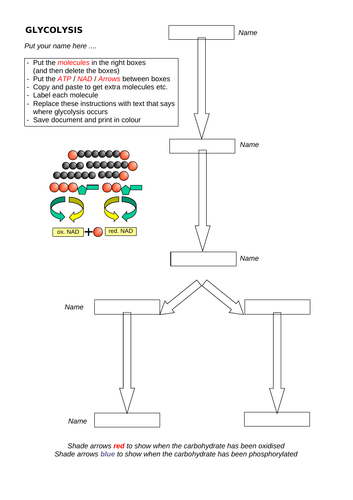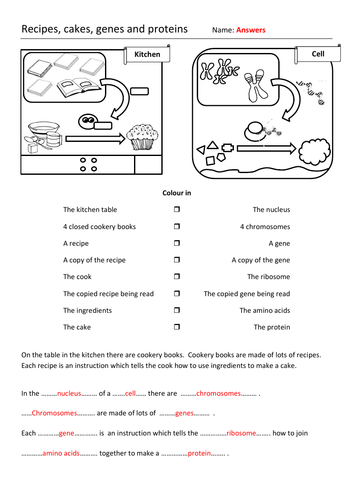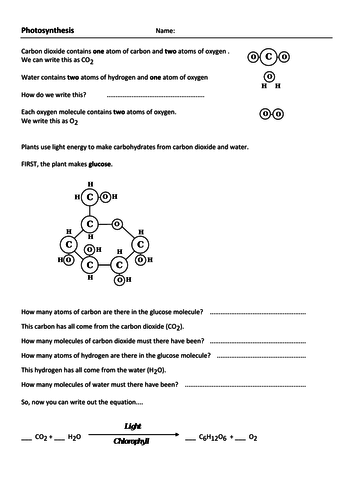68Uploads
34k+Views
38k+Downloads
Biology

Dihybrid crosses, Chi-squared and Mendel
Interactive presentation which takes students through using the chi-squared test to check the significance of results from a dihybrid genetic cross. Uses examples from Mendel’s pea plant experiments. Can be used on a smartboard to reveal each stage after quizzing the students. 6 slides. Written for A-level.
Key words
Dihybrid cross, Inheritance, Sweet peas, Mendel, Chi squared, Genetics

Genetic Modification: Good or bad (Categorising activity)
Students choose from a bank of statements. They categorise the statements as advantages or disadvantages. Different students will take different points of view. They then have to write a sentence to justify each choice. A cut and stick exercise designed to provokes discussion. To complete the activity students must engage with the concepts. There are no ‘right’ answers! 3 pages
Key words
Genetic modification, GM, Ethics, Genetic engineering,

GCSE Digestion - complete the powerpoint activity
A powerpoint for students to edit and complete. Written as a cover lesson to give fairly disaffected / less able students something a bit more interesting to do than 100 minutes of worksheets. The answer sheet gives suggested extensions for those who finish first / want them. It would work well as a VLE homework activity or as revision.
Key words,
Digestion, Digestive system, Enzymes, Absorption, Excretion

The long term effects of exercise cloze/crossword (A-level)
This is a cloze activity with the words (2D, 24A) linking into a crossword. Covers fitness, heart rate, ATP production, breathing, oxygen uptake and muscle development. 2 pages with an answer sheet. Written to accompany A-level Biology.

GCSE Circulation and Transport Revision Worksheet
Double sided GCSE revision worksheet - Circulatory system and Transpiration.
Anagrams, Join the word to the definitions, True/False, Cloze - a bit of everything, really.
Answer sheet provided.
Key words
Blood, Heart, Xylem, Transpiration, Platelets, Stomata

Sexual and Asexual Reproduction Comparison (GCSE)
A double sided GCSE worksheet with answer sheet. Pros and cons of sexual/asexual reproduction.
Recall, Cloze, Free response, short answers.
Strawberries, potatoes, mice, amoebae and gardeners.

Glycolysis - drag and drop activity
Students edit the Word document to show the stages of glycolysis (oxidation, phosphorylation etc). The molecules are all drawn for them (hexose, glucose, phosphates); they need to copy and put them in the right places. 1 page, accompanied by an answer sheet. Written for A-level students. Works well on VLE as homework but I tend to use it where I can watch what their misconceptions are and deal with them. (‘ctrl d’ doubles an object, which is useful).

Genes and Proteins (Recipe, Cake analogy) GCSE
My lower ability GCSE students struggled distinguishing between genes ‘being’ the protein and genes ‘coding’ for the protein. The language was a barrier - weird, abstract words. This sheet uses a recipe-cake / gene-protein analogy with a bit of colour coding. The students enjoyed it and understood it. (I pointed out that medical students use colouring in to learn anatomy). Answers included

Photosynthesis - Equation & The uses of glucose (GCSE)
Worksheet with questions leading the students on to balance the equation for photosynthesis and then looking at what the glucose is used for in the plant. Double sided accompanied by an answer sheet

Classification - A-level (Powerpoint and two worksheets)
Fully hyperlinked 30-slide powerpoint and two worksheets. Used with A-level students.
Written in frustration at the lack of material available to stretch bright students on this subject; classification and phylogeny. The concepts can be difficult for students from 14-16 yrs but they do engage with them. Designed to generate discussion about some of the more contentious issues involved in classification. Two double-sided worksheets with answer sheets.

24 piece DNA, Genes and Chromosomes revision hexagon puzzle
Triangle puzzle on ‘DNA, genes and chromosomes’ where students match sentence fragments to construct a large hexagon. It is a revision activity which works across the ability range and is enjoyed by students. Weaker students need hints! It could be used for groups of three, and it works well as a race. An answer sheet is provided. Written to support A-level Biology.

AQA Science subject specific vocabulary cue cards
36 Cue cards for AQA 9-1 GCSE Science (and AQA A-level Biology) Subject Specific Vocabulary.
Word on one side, definition from the exam board guidance on the other.
I’ve used them on the VLE.
When printing: flip on short edge

Lipids (A-level Biology) - Crossword; Question sheet; Structures info sheet
A set of resources I wrote to support Year 12 students learning about lipids.
The crossword is linked to a cloze activity: “Lipids are made of three 7A … joined with 3A… bonds to a 6A … molecule” etc. The question sheet is a double sided summary to test what they’ve learnt. The structure sheet lays out the structures of lipids, phospholipids, ways of representing them, ester bonds and saturated/unsaturated.

B2(D): Digestion Glossary and 2 Crosswords (AQA 9-1 GCSE Science)
Organisation (Digestion) Glossary: Written for AQA 9-1 GCSE Science but it would relate to other specifications. I wrote it by going through the syllabus/textbooks and picking out a mixture of key words and words which I thought students might not know. I’ve put in student-friendly definitions. It covers the digestion part of the topic which we teach separately from the transport and non-communicable parts.
There are two crosswords (about 20 words in each), based directly on the glossary. I tend to give neighbouring students different crosswords and so avoid too much copying. They are about the same difficulty so could be used competitively. They are deliberately straightforward to test the extent to which they have learnt the vocabulary.

B2(T): Transport Glossary and 3 Crosswords (AQA 9-1 GCSE Science)
Organisation (Transport / Non-communicable Disease) Glossary: Written for AQA 9-1 GCSE Science but it would relate to other specifications. I wrote it by going through the syllabus/textbooks and picking out a mixture of key words and words which I thought students might not know. I’ve put in student-friendly definitions. It covers the transport and non-communicable disease part of the topic which we teach separately from the digestion parts.
There are three crosswords (about 20 words in each), based directly on the glossary. I tend to give neighbouring students different crosswords and so avoid too much copying. They are about the same difficulty so could be used competitively. They are deliberately straightforward to test the extent to which they have learnt the vocabulary.
Answer keys are included.

B1 Cell Biology Glossary and 3 crosswords (AQA 9-1 GCSE Science)
Cell Biology Glossary: Written for AQA 9-1 GCSE Science but it would relate to other specifications.
Three crosswords (20+ different words in each), based directly on the glossary. I give neighbouring students different crosswords and so avoid too much copying. They are about the same difficulty so could be used competitively. They are deliberately straightforward to test the extent to which students have learnt the vocabulary.

Flower structure
Students use a crossword to label a diagram of a flower (sepal, petal, stigma, stamen, ovary, carpel etc). Two versions: one basic (omitting androecium, calyx etc), the other more testing. Can be used following flower dissections - students who finish first get on with the crossword. Answer sheets provided.
I’ve used it with whichever aged students I happen to be dissecting flowers with.

B4: Bioenergetics Glossary and 2 Crosswords (AQA 9-1 GCSE Science)
Bioenergetics Glossary: Written for AQA 9-1 GCSE Science but it would relate to other specifications. I wrote it by going through the syllabus/textbooks and picking out a mixture of key words and words which I thought students might not know. I’ve put in student-friendly definitions. It covers the transport and non-communicable disease part of the topic which we teach separately from the digestion parts.
There are two crosswords based directly on the glossary. I tend to give neighbouring students different crosswords and so avoid too much copying. They are about the same difficulty so could be used competitively. They are deliberately straightforward to test the extent to which they have learnt the vocabulary.
Answer keys are included.

B3: Infection Glossary and 2 Crosswords (AQA 9-1 GCSE Science)
Infection and Response Glossary: Written for AQA 9-1 GCSE Science but it would relate to other specifications. I wrote it by going through the syllabus/textbooks and picking out a mixture of key words and words which I thought students might not know. I’ve put in student-friendly definitions. It covers the transport and non-communicable disease part of the topic which we teach separately from the digestion parts.
There are two crosswords based directly on the glossary. I tend to give neighbouring students different crosswords and so avoid too much copying. They are about the same difficulty so could be used competitively. They are deliberately straightforward to test the extent to which they have learnt the vocabulary.
Answer keys are included.

Heart Disease and Smoking Data Analysis - 'Edit the powerpoint' task (GCSE)
Heart disease and smoking - data analysis task - A powerpoint for students to edit and complete. Written to give less able students something more interesting to do than endless worksheets. It worked pretty well when I used it in the computer rooms. I used it after a heart dissection. The answers are included as a second powerpoint. It is sufficiently general for any syllabus and concentrates on How Science Works. Would be easy to use on the VLE as a homework activity.

